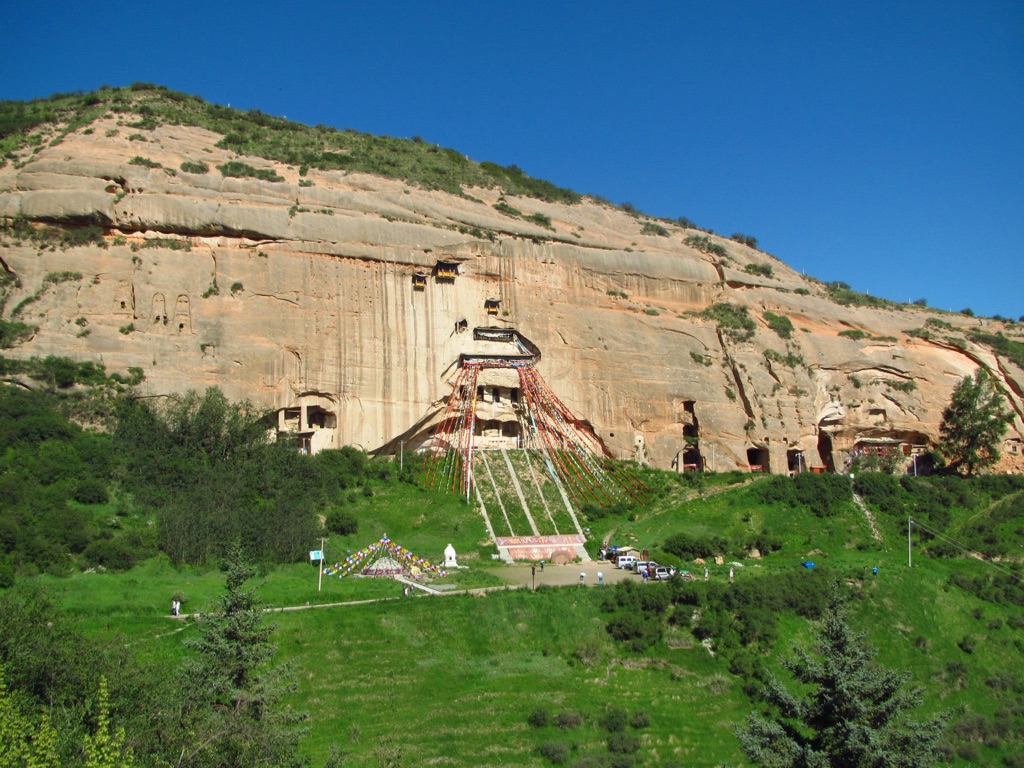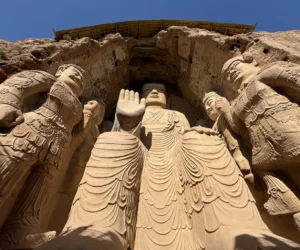Tianti Mountain Grottoes: A Journey Through Time The Tianti Mountain Grottoes, also known as Tiantishan Caves, are a treasure trove of Buddhist art and history. Located in the Liangzhou District of Wuwei, Gansu, China, these caves have witnessed centuries of religious devotion, artistic creation, and natural wear. Origins and Historical Significance The grottoes were first…
Northern Liang Dynasty
The Northern Liang Dynasty (AD 397-439) was a significant period in the history of ancient China, marking a time of cultural diversity and military strife. It was one of the Sixteen Kingdoms, a series of non-Han Chinese states that existed in the north of China during the Jin Dynasty’s fragmentation. The Northern Liang was founded by Juqu Mengxun, a member of the Xiongnu nomadic people, in the Hexi Corridor region, showcasing the blend of nomadic and settled cultures that characterized this era.
The civilization timeline of the Northern Liang Dynasty was marked by its strategic location along the Silk Road, which facilitated not only trade but also cultural exchanges between the East and the West. This position helped the Northern Liang to become a melting pot of different cultures, including various Central Asian influences. The dynasty’s capital was initially set up in Gaochang (modern-day Turpan) but later moved to Zhangye. Throughout its existence, the Northern Liang was a key player in the complex political and military landscape of northern China.
Religion played a significant role in the Northern Liang Dynasty, with Buddhism being particularly prominent. The dynasty is noted for its patronage of Buddhist art and architecture, as evidenced by the construction of temples and the commissioning of Buddhist statues and murals. This period saw an influx of Buddhist missionaries from Central Asia, contributing to the spread and localization of Buddhism in China. The Mogao Caves near Dunhuang, though primarily developed under later dynasties, began to see significant construction during this period, laying the foundation for what would become a major Buddhist site.
Social and daily life in the Northern Liang Dynasty was characterized by a blend of nomadic traditions and settled agricultural practices. The society was stratified, with a ruling class of Xiongnu origin and a diverse population that included Han Chinese, Central Asians, and other groups. Agriculture, particularly the cultivation of wheat and barley, was a staple of the economy, supplemented by trade along the Silk Road. The military was a crucial aspect of life, with many men serving in the cavalry, a testament to the dynasty’s nomadic roots.
The rulers of the Northern Liang Dynasty were from the Juqu family, with Juqu Mengxun being its founding figure. His leadership was marked by efforts to consolidate power and maintain independence amidst the turbulent politics of the era. Following his reign, the dynasty saw a succession of rulers who navigated alliances and conflicts with neighboring states, including the Northern Wei Dynasty, which eventually led to the Northern Liang’s downfall. The last ruler, Juqu Mujian, was captured in AD 439, marking the end of the dynasty as it was absorbed into the expanding Northern Wei territory.
Throughout its existence, the Northern Liang Dynasty was involved in numerous wars and battles, both as a defender and an aggressor. Its strategic location made it a target for conquest, but also provided it with opportunities to expand its influence. The dynasty’s military campaigns were often directed against rival states in the region, including the Northern Wei, with whom it had a particularly contentious relationship. The Northern Liang’s military strategies were influenced by its nomadic heritage, emphasizing mobility and cavalry tactics.
Despite its eventual fall, the Northern Liang Dynasty left a lasting impact on the cultural and religious landscape of China. Its contributions to the development of Buddhism in the region were particularly significant, helping to lay the groundwork for the religion’s flourishing in subsequent dynasties. The dynasty’s history also provides valuable insights into the complexities of cultural integration and the dynamics of power in ancient China, illustrating the interplay between nomadic and settled societies.
In conclusion, the Northern Liang Dynasty was a period of significant cultural, military, and political activity in ancient China. Its history reflects the broader trends of the time, including the fragmentation of power, the importance of the Silk Road in facilitating cultural exchange, and the spread of Buddhism. Despite its relatively short existence, the Northern Liang Dynasty played a crucial role in the development of Chinese civilization, leaving a legacy that continued to influence subsequent generations.

Mati Temple grottoes
The Mati Temple grottoes, nestled in the cliffs of the Hexi Corridor, are a stunning example of Buddhist art and architecture. These grottoes, also known as the Horse’s Hoof Temple, are a series of caves carved into the rock face, showcasing a rich collection of Buddhist statues and frescoes. They are located in Gansu Province, China, and represent a fusion of Indian Buddhist art with Chinese cultural influences. The site is a testament to the spread of Buddhism along the Silk Road and is a valuable piece of cultural heritage that has attracted scholars, tourists, and pilgrims for centuries.

